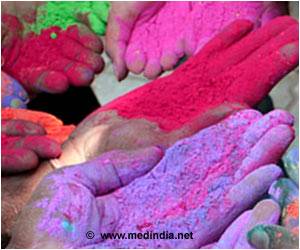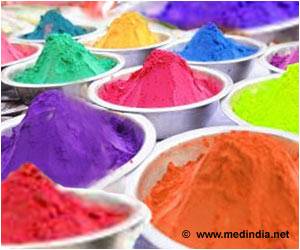While celebrating Holi, be informed that the colors you’re throwing at one another could be made up of toxic chemicals that might result in health hazards.

- Holi, the festival of colors, welcomes the season of spring with its new colors and life.
- On the day of holi celebration, people get together in a common place and throw colors on one another. Originally, the holi colors were made up of the bright new flowers that blossomed during the spring season.
- Modernization and industrialization have replaced the natural sources of the colors with cheap industrial dyes that are synthesized via chemical processes giving rise to health hazards.
The spring season, during which the weather changes, is believed to cause viral fever and cold. Originally, the holi colors were made up of the bright new flowers that blossomed during the spring season. Different shades of colors were made from those flowers, which acted as the raw materials. The colors were traditionally made of neem, kumkum, haldi, bilva, and other medicinal herbs. Also, the trees from which the flowers were taken possessed medicinal properties that were beneficial to people’s skin.
Modernization and industrialization have replaced the natural sources of the colors with cheap industrial dyes that are synthesized via chemical processes. This results in people suffering from various health hazards after the celebration. The colors are made up of chemicals and the dry color powders are made up of 2 components – a base and a color giving substance.
Here’s a List of Popularly Used Colors and Their Chemical Ingredients
Green: Malachite green & copper sulphate
Red: Mercury Sulphate
Silver: Aluminium bromide
Rhodamine: Pinkish-red
Auramine: Yellow
Purple: Methyl violet
Orange: Orange II
The base is usually either wheat flour or starch and their contamination could be hazardous. Sometimes to give the colors a sparkling effect, Mica dust is added to the dry powders.
Major Health problems encountered after the celebration of Holi:
- Dermatoses (skin diseases)
- Ocular (eye-related) problems
Skin problems occur very frequently after the celebration using colors where people experience burning sensation and irritation. The face is the most affected part of the body mainly because it is where people commonly apply colors. Hands are also affected as they are involved in the preparation of colors and smearing them on people. Apart from these, people also scrub vigorously in order to get rid of the colors post celebration, which causes skin abrasions. The dermatoses that follow holi celebration are mainly due to allergic or irritant contact skin inflammations (dermatitis). There might be cases when people experience worsening of skin diseases that they already exhibited like eczema, acne and paronychia.
The major symptoms noted are Pruritus (Itching), burning sensation, pain, scaling, oozing, eczematous lesions, xerosis, erythema and abrasions.
Ocular Problems: When colors are splashed and smeared over the face, it is likely that they enter the eyes and cause problems like conjunctivitis or corneal abrasions. The major colors reported with higher incidence of ocular toxicity are green or bluish-green which are made up of malachite green which could cause ocular irritation and sometimes epithelial defect.
Major symptoms noted: Redness, watering and grittiness.
Holi Celebrators Who Turned Victims of Life-threatening Hazards
- There has been a case where a 4-year-old boy was diagnosed with methemoglobinemia (a condition where methemoglobin or oxygen-carrying metalloprotein hemoglobin instead of the normal haemoglobin is present in the blood). When methemoglobin levels are higher than 70%, it could be fatal. In this case, it happened due to an accidental ingestion of paint thinner that had been mixed with the colors used in holi celebration.
- There was a case when a 57 year old patient who had symptoms of excessive watering, redness and foreign body sensation in both his eyes along with skin ulcers and painful and swollen eyes. He was diagnosed with a fatal inflammatory infection called periorbital necrotizing fasciitis after celebrating the festival of colors. The above mentioned disease usually occurs only after trauma, especially in cases of chronic alcoholics, diabetes or immunocompromised patients. This uncommon tissue infection affects lower extremities and the abdomen is caused by streptococcus & staphylococcus. It has a high mortality rate of 12.5%. The patient had no history of any systemic disease, but just that of having played holi three days earlier. The use of mica dust for shine in holi colors could cause microtrauma of skin and cause infections. Use of contaminated wheat flour/starch can also increase the chances of skin and eye infections.
There have been no quality checks on the holi colors that are manufactured in India. The colors that are either sold freely or in packets at the market give no information about the their source contents or any possibilities of toxic effects that they might cause. Recently, there have been quite a number of NGOs who campaign on safe practices to follow while using colors during holi celebration. Some of them have also been making safer colors sourced from natural ingredients like flowers and vegetables and marketing them.
We can prevent health hazards after holi celebration only when we take efforts at a large scale such as
- Increasing awareness among the public regarding the health hazards caused by harmful colors.
- Widespread availability of alternative colors that are safer to use, sold at affordable prices.
- The government should perform regulatory checks on the production and marketing of hazardous chemicals.
- All doctors should caution the public against the use of synthetic dyes during holi celebration.
- The manufacturing process of colors should go under the guidelines of the Food & Drug cosmetic act according to the Indian Bureau of Standards.
- Sudip Kumar Ghosh, Debabrata Bandyopadhyay, Gobinda Chatterjee, and Debabrata Sahathe ‘Holi’ Dermatoses: Annual Spate Of Skin Diseases Following The Spring Festival In India Indian J Dermatol. 2009 Jul-Sep; 54(3): 240–242. Doi: 10.4103/0019-5154.55632 Pmcid: Pmc2810689
- Deepender Chauhan, MS,corresponding author Ritu Arora, MD, Sima Das, MS, Daraius Shroff, MS, and Ritesh Narula, MBBS Bilateral periorbital necrotizing fasciitis following exposure to Holi colors: A case report Indian J Ophthalmol. 2007 Sep-Oct; 55(5): 373–374. PMCID: PMC2636027
- Velpandian T1, Saha K, Ravi AK, Kumari SS, Biswas NR, Ghose S Ocular hazards of the colors used during the festival-of-colors (Holi) in India--malachite green toxicity. J Hazard Mater. 2007 Jan 10;139(2):204-8. Epub 2006 Jun 23.
- Sankar J1, Devangare S, Dubey NK. Survival with 98% methemoglobin levels in a school-aged child during the "festival of colors". Pediatr Emerg Care. 2013 Oct;29(10):1102-3. doi: 10.1097/PEC.0b013e3182a60024











